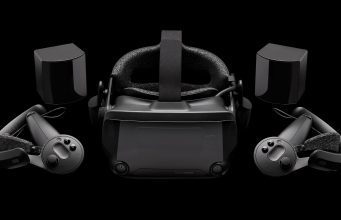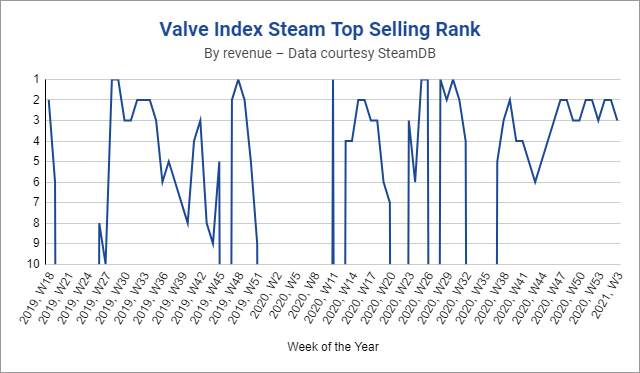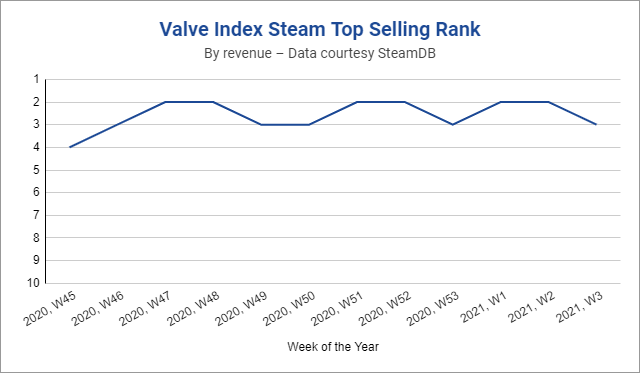
A small number of people willing to buy an expensive product can really add up, as Valve is finding with its high-end Index headset. Despite supply shortages brought on by the Coronavirus pandemic, the headset has made frequent appearances among the best selling products on Steam by revenue, including an ongoing 13 week streak in the top 5.
From a unit standpoint, it’s unlikely that the $1,000 Valve Index is selling all that many headsets compared to cheaper headsets like Oculus Quest. But from a revenue standpoint, the headset seems to be treating Valve very well.
Although Valve doesn’t share how much revenue individual products make on its platform, Steam does rank the top selling products, by revenue, each week. SteamDB maintains an archive of the weekly top 10.
With Valve Index supply ramping back up after supply disruptions, we can see that the $1,000 headset has been among the top five best selling products for 13 weeks running.
It’s worth remembering that the ranking is by revenue; to put things into perspective, each Index kit sold costs the same as about 17 games at $60 each. Still, it seems quite impressive that the headset’s revenue is ranking alongside some of the world’s best selling games. On certain weeks over its 13 week streak, Index has surpassed the weekly revenue of major games like Cyberpunk 2077, Red Dead Redemption 2, and others.
 Looking at the historical data, we can see how often the headset has permeated the top 10 best selling Steam products of each week, including eight separate weeks where it’s topped the charts at #1.
Looking at the historical data, we can see how often the headset has permeated the top 10 best selling Steam products of each week, including eight separate weeks where it’s topped the charts at #1.
 Given how infrequently Valve’s own Half-Life: Alyx has appeared in the top 10, we’d wager that the headset has earned the company far more revenue. Granted, profit is a different story; Valve isn’t believed to be making much profit from each Index sold, but still, a large revenue stream generated by the headset is overall a good thing for the company, as long as it’s breaking even or better.
Given how infrequently Valve’s own Half-Life: Alyx has appeared in the top 10, we’d wager that the headset has earned the company far more revenue. Granted, profit is a different story; Valve isn’t believed to be making much profit from each Index sold, but still, a large revenue stream generated by the headset is overall a good thing for the company, as long as it’s breaking even or better.
While the headset’s placement among the top 10 best selling Steam products is certainly affected by the seasonal nature of major game releases, the long term look at the ranking likely also signals how the headset’s availability has fluctuated since release. We can see large gaps in the headset’s top 10 appearance for 6 weeks right after its release in mid-2019, as well as a 12 week gap at the start of 2020, and a 4 week gap in mid-2020.
In a recent interview with New Zealand’s 1 News, Valve head Gabe Newell explained how the Coronavirus pandemic hampered the company’s ability to meet the demand for the headset.
“We actually have components that are manufactured in Wuhan [where the outbreak began] and when you’re setting up your manufacturing lines it doesn’t occur to you that you’re suddenly going to be dependent on this peculiar transistor that’s sitting on one board that you can’t get,” Newell said.
“[Everyone who builds electronics] ended up running into the same problem simultaneously—you go from, ‘Oh, we’re in great shape,’ to, ‘What do you mean Apple or Microsoft just bought the next two years’ supply of this just so they could make sure they aren’t going to run out?'”
“You went from a situation where everything was getting done just in time to people buying up all the available supplies.
“[…] we’re very much manufacturing constrained.”
While the company indeed struggled to keep up with demand in 2020, supply appears to be picking up rapidly as 2021 gets underway.
The post Despite Shortages, Valve Index Among Steam’s 5 Best Selling Products for 13 Weeks Straight appeared first on Road to VR.
Ream more: https://www.roadtovr.com/valve-index-best-selling-steam-products-streak/

No comments:
Post a Comment